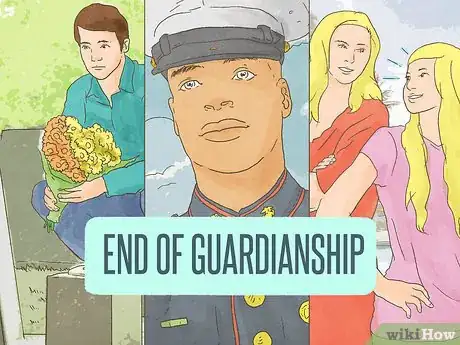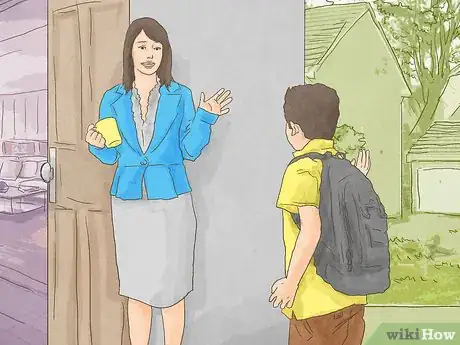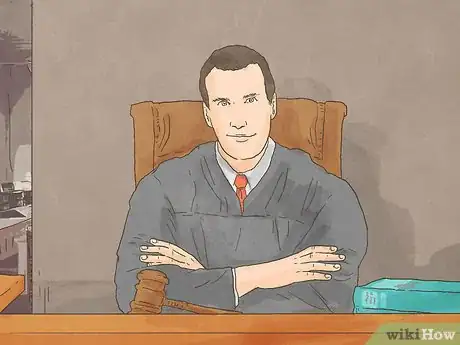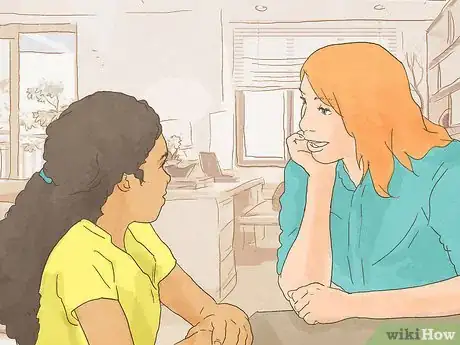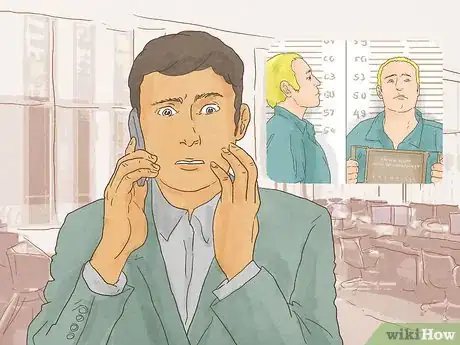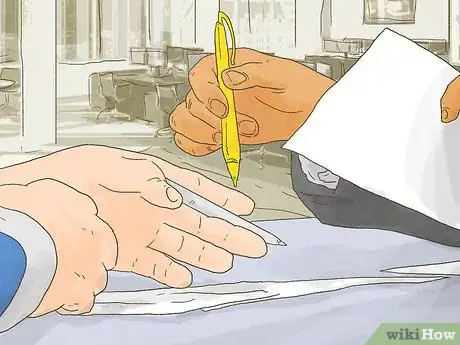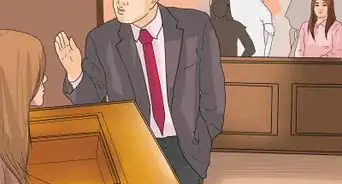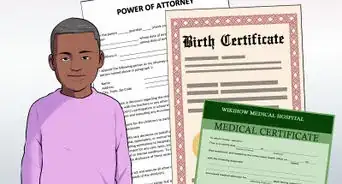This article was co-authored by Clinton M. Sandvick, JD, PhD. Clinton M. Sandvick worked as a civil litigator in California for over 7 years. He received his JD from the University of Wisconsin-Madison in 1998 and his PhD in American History from the University of Oregon in 2013.
There are 16 references cited in this article, which can be found at the bottom of the page.
This article has been viewed 67,291 times.
A legal guardian has control of a legally incapacitated person and the person's finances or estate. In some cases, a legal guardian may also have legal custody of that person. Minors and adults unable to care for themselves due to illness or disorder are commonly assigned guardians. An incapacitated person under the care of a guardian is called a “ward.” When a person has guardianship of another, that person is responsible for the ward until another guardian is appointed or the court no longer considers the ward incapacitated. In some jurisdictions, the term “custodial” or “conservator” is used instead of the term “guardian.” Some jurisdictions may also use different terms for different guardian roles, e.g., “conservator” for a guardian of the elderly.[1] Laws regarding guardianship vary by state, and you should research which laws apply to your situation.
Steps
Terminating a Guardianship
-
1Understand the ways that guardianships can end. Guardianships can come to an end in many different ways. A court can issue an order to terminate a guardianship. A guardian may also resign after a court hearing is held. The ward (if 12 or older) or the ward’s parents (if the ward is a minor) may request the court to end a guardianship.[2]
- For guardians of minors, a guardianship may end in several other ways:[3]
- The minor turns 18.
- The minor dies before turning 18.
- The minor is legally adopted, joins the military, gets married or is emancipated (declared legally an adult) by a court order.
- The guardian fails to renew the guardianship (if a temporary guardianship has been assigned).
- A guardianship may also end if the court determines that the ward is no longer incapacitated. For example, if an elderly ward was assigned a guardian due to a severe illness but has since recovered, the courts may decide to terminate the guardianship.
- In many states, any person who is “interested in the protected person’s welfare” may petition the court to terminate the guardianship if the ward is no longer incapacitated.[4]
- For guardians of minors, a guardianship may end in several other ways:[3]
-
2A good reason exists to terminate the guardianship. The ward (if 12 or older), the parents of the ward (if the ward is a minor) or the guardian can request to end the guardianship.[5] Usually, a court hearing will need to happen for the guardianship to end.
- Reasons for changing legal guardianship include marriage, divorce or inability/unwillingness of the prior guardian to continue.
- For example, consider a situation in which two married individuals are the guardians of a relative who is still a minor. If the couple divorces, one person may no longer wish to be a guardian of the minor.
- If the current guardian must move to a different state, it may be appropriate to appoint a new in-state guardian.
- If terminating the guardianship of an adult, the parties may have to provide medical records or a doctor’s note to prove the end of the ward’s incapacitation. Check your state’s legal code to determine if the state will require medical evidence to terminate the guardianship.
- At the hearing, the judge will determine whether terminating the guardianship is in the ward’s best interest.
- Judges have the right to refuse a request to terminate the guardianship if it seems unfounded or frivolous. The court must provide a written explanation of the reasons for the rejection.
Advertisement -
3Consider whether a temporary guardianship is appropriate. In some cases, you may not need to request that a guardianship be permanently terminated. Temporary guardianships last for a pre-determined, limited period of time. They are usually created in response to a specific situation, such as an emergency.[6]
- For example, if the ward’s current legal guardian will be unavailable for an extended period of time, perhaps because the legal guardian is leaving the country, you can request a temporary substitution. The current guardian can request to appoint a specific person to act on his/her behalf.[7]
- Caregivers of elderly persons who are also legal guardians may be able to request a temporary substitute guardian to give them some relief.
- An “emergency” guardianship does not necessarily require an emergency. This type of guardianship can be applied for if the situation is time-sensitive. For example, you might request a temporary emergency guardianship if a child needs immediate medical treatment or to be enrolled in school (things a minor cannot do on his/her own).[8]
- The ability to request a temporary guardian varies by jurisdiction. Some jurisdictions will only allow temporary guardianships in the case of emergency.[9]
-
4Fill out the appropriate forms. Depending on your jurisdiction, you will need to fill out several forms to request a termination of a guardianship. These forms may vary by state and/or county or municipal jurisdiction. Your local court may have a family law facilitator who can help you determine which forms to fill out. In some states, you may need to create a written request to end a guardianship.
- For example, in California, you must fill out a Petition for Termination of Guardianship, a Notice of Hearing -- Guardianship or Conservatorship and an Order Terminating Guardianship form. In addition, you must fill out any forms required by the local California court.[10]
- If the guardianship is of an incapacitated adult, you may need to fill out forms or complete a written request. Your court will tell you which process you should do.
- The National Center for State Courts maintains a database of many state courts, including supreme and municipal courts.[11] You can also find helpful information about which courts deal with the guardianship of minors in each state via Bridging Refugee Youth & Children’s Services.
-
5Submit the relevant forms. You will usually need to file your request in the same court that created the guardianship. Make at least three copies of your forms. Submit the originals to the clerk at your local courthouse.[12]
- Some states will appoint a Guardian Ad Litem during the termination process.[13]
The Guardian Ad Litem is appointed by the court to represent the best interests of the ward but does not have any of the rights or duties of a legal guardian.
- In Wisconsin, the court appoints a licensed attorney who serves as the Guardian Ad Litem for the ward.
- In North Carolina, a volunteer Guardian Ad Litem advocate may be assigned along with a Guardian Ad Litem attorney.
- A Guardian Ad Litem will investigate the issues cited in the request to terminate the guardianship and may also interview the ward, guardian and any other relevant parties.
- Some states will appoint a Guardian Ad Litem during the termination process.[13]
The Guardian Ad Litem is appointed by the court to represent the best interests of the ward but does not have any of the rights or duties of a legal guardian.
-
6Give legal notice to the relevant parties. Anyone who was given notice when the guardianship was originally filed, such as the parents of a minor child or relatives of a ward, must be given notice that you are seeking to terminate the guardianship. This notice must usually be given a minimum of two weeks in advance.[14]
- If you do not know where the relevant parties are, you may be able to place a notice in the newspaper to serve as notification. You may also be able to file a "Request to Dispense with Notice" form if you are unable to locate the persons you need to notify.[15]
- You do not need to give notice to relatives or parties who agree to end the guardianship. In most cases, it is sufficient for them to sign a consent form or written statement.[16] You will need to provide proof of this agreement to the court.[17]
- If a social welfare department, such as a department of family and child services, was involved in instituting the guardianship, you must also notify the department.[18]
-
7Attend a court hearing. If the court considers your request to terminate the guardianship valid, the court clerk will schedule a hearing. The court will notify you of the time and place of this hearing. You will need to attend this hearing to explain why you are requesting to terminate the guardianship.
Considering a New Guardian
-
1Consider the ward’s incapacity. If the ward will still be incapacitated when the old guardianship ends, a new guardian should be appointed.
- If the ward is no longer incapacitated, the guardianship can be terminated upon the parties’ request.
-
2Review the current Order of Guardianship. If the current order names a successor, that person is the first choice for new guardian.[19]
-
3Talk to the ward. Find out the ward’s wishes regarding the new guardian. Many states require the ward to consent to the guardianship or allow the ward to challenge the guardianship in court.
- If the ward is a minor, it may not be legally necessary to consider the ward’s wishes.
-
4Consider appointing an experienced lawyer as guardian. An attorney will have the needed expertise to handle the ward’s financial and legal affairs.
- Visit a state bar referral website to find an experienced attorney in your area.
-
5Talk to the proposed guardian. A guardianship entails serious responsibilities. Make sure the proposed guardian is willing and able to meet them. A guardian has the legal obligation to act in the best interest of his/her ward, but the guardian do not have to respect the ward’s wishes if those wishes are contrary to the ward's best interests.[20] Some of the major responsibilities include:
- Responsibility for a ward and his/her assets and estate.
- In some cases, guardians may liquidate the ward’s assets to cover expenses.[21]
- Responsibility for regular accountings and reports with the court
- Responsibility for decisions about the ward’s living situation (for example, whether the ward lives with a relative, independently or in an assisted living community).
- In most cases involving guardianship of a minor, the guardian must get the court’s permission to move the minor outside of the state.[22]
- Responsibility for arrangements related to the ward’s food, clothing and shelter.
- In the case of minors, responsibility for decisions about the ward’s education, including the school’s location and making sure the ward attends regularly and without major problems.
- Responsibility for the ward’s medical and dental care.
- Responsibility for the ward’s financial decisions, including savings and investment decisions, living allowances and bill-paying.
- Responsibility for a ward and his/her assets and estate.
-
6Look for non-profit agencies in your area that offer experienced guardianship services. Though perhaps not ideal for everyone, these services can greatly benefit those in need only of a guardian of an estate or those without any close family members who can serve as a guardian.
- Look online for “free legal help with a guardianship” to find a non-profit in your area.
- Many legal-aid programs also offer help appointing a guardian. To find a legal-aid program in your area, visit LawHelp.org.
-
7Understand that a court investigator may be appointed. Some states will appoint a "court investigator" to interview a potential guardian. This investigator is responsible for determining whether the potential guardian will be able to act in the ward's best interests. The investigator may also interview relatives and other relevant parties.[23]
- For a minor, a home visit will likely be scheduled. The investigator will visit the home where the minor will reside, interview the minor and the guardian(s) and perform a background check of the guardian.
Appointing a New Guardian
-
1Consult with a lawyer. It is always recommended that you consult with a family lawyer when applying for guardianship. A lawyer can help you navigate the process and ensure that everyone’s rights are protected. In certain cases, applying for new guardianship can be even more complicated. You should consult with a lawyer if any of the following situations apply:[24]
- The ward has very valuable property or estate.
- The guardian lives in another state than the ward.
- Other legal cases involving the ward are currently ongoing.
- The ward has special needs (e.g., a developmental or severe physical disability).
- The ward is Native American (federal laws apply in these cases).
-
2Ensure the proposed guardian is qualified. States may have varying requirements for guardianship, so check your state’s code.
- Many states prohibit those who have been convicted of a felony, who have filed for bankruptcy protection or who do not live in-state from serving as guardian.[25]
- You can find your state’s legal code regarding guardianship on the state’s website. Most publish the code directly on the website.
- Try using the Internal Revenue Service’s listing of state government websites to find yours. Or you can try the state code list at FindLaw.
-
3Gather the necessary forms. Be sure to use the forms that your state provides. The court won’t accept forms from other states. There are several resources you can use to locate the necessary forms:
- Your state or county’s website. You can find your state court’s website on the National Center for State Court’s directory.
- The Clerk of the Courts. The clerk’s office can often provide you with court-approved forms and with some assistance in completing and filing them. Call or stop by the clerk’s office to ask if guardianship forms can be provided.
- Ask a professional. If you can't locate the proper forms on your court’s website and the clerk can't provide you with the proper forms, you may wish to consult a paralegal or legal document preparation company. These companies can offer inexpensive forms and assistance completing them.
- Though the particular forms may vary by state, most states require the following:
- If you need to appoint a new guardian, you’ll need a Petition to Appoint Successor Guardian, an Order Appointing Successor Guardian, consent from all parties and the proper notices.
- If a guardian is no longer needed, you’ll need a Petition to Terminate Guardianship and an Order Terminating Guardianship.
-
4Fill out the necessary forms. If you’re unsure about filling out the forms on your own, consider consulting an attorney. If you fill out the forms yourself, consider these tips:
- Look on the current Guardianship Order, previous guardianship paperwork or contact the clerk’s office to find your case or cause number.
- Read any included instructions all the way through before beginning. Follow them carefully.
- Check with the court clerk if you’re unsure what information is required or what a question is asking.
- Be sure to obtain all required signatures and get them notarized, if necessary.
-
5File the forms with the court. Before filing, check with the court clerk to determine how many copies of each document you’ll need and whether you will need to pay a filing fee. If you’re applying to be appointed guardian and aren’t able to pay the filing fee, ask the court clerk for an application for a fee waiver or inquire if financial assistance is available.
- Bring the necessary number of copies along with your filing fee (if applicable) to the clerk’s office.
- The clerk’s office will assist you with filing the forms in the proper court.
- Keep a copy of the forms for your records.
-
6Attend any scheduled hearings. If your state law requires it, you may have to attend a brief hearing. To determine whether your state requires a hearing, see the American Bar Association’s [www.americanbar.org/content/dam/aba/administrative/law_aging/2012_aging_gshp_adult_gship_hdbks_state_6_2012.pdf Adult Guardianship Handbook].
- If your state requires a hearing, consult an attorney to represent you. In states that require a hearing, an attorney is the only one who can appear on behalf of a potential guardian.
- If you don’t have income for an attorney, consider seeking out a legal-aid clinic in your area, which may be able to advise you or help you find free representation.
-
7Wait for the Order of Guardianship. The court should mail you a copy of the order granting you guardianship within 30 days of your hearing or within 30 days of filing your paperwork if there was no hearing.
- If you don’t receive the order and more than 30 days have passed, call the clerk’s office for the county in which you filed to inquire about the status of the guardianship. The clerk should be able to tell you if there are problems or if the court is just running behind.
- If your petition for guardianship is denied, discuss your options with your attorney or hire an attorney immediately. There’s a possibility you can appeal the court’s decision. Whether that’s a good idea depends on your particular case, and you shouldn’t make that decision without consulting an attorney.
Warnings
- This article is for informational purposes only. It does not constitute legal advice. State laws vary widely. You should contact a family law specialist if you have any additional questions about this process.⧼thumbs_response⧽
References
- ↑ https://www.law.cornell.edu/wex/guardian
- ↑ http://www.courts.ca.gov/1213.htm
- ↑ http://www.courts.ca.gov/1213.htm
- ↑ https://www.utcourts.gov/howto/family/gc/ending.html
- ↑ http://www.courts.ca.gov/1213.htm
- ↑ http://www.courts.ca.gov/1212.htm
- ↑ http://www.legalmatch.com/law-library/article/temporary-guardianship-laws.html
- ↑ http://www.courts.ca.gov/1212.htm
- ↑ http://www.legalmatch.com/law-library/article/temporary-guardianship-laws.html
- ↑ http://www.courts.ca.gov/1213.htm
- ↑ http://www.ncsc.org/Information-and-Resources/Browse-by-State/State-Court-Websites.aspx
- ↑ http://www.courts.ca.gov/1213.htm
- ↑ http://www.ksfamilylaw.com/FAQS/guardial_ad_litem_gal/
- ↑ http://www.courts.ca.gov/1212.htm
- ↑ http://www.courts.ca.gov/1212.htm
- ↑ http://www.courts.ca.gov/1213.htm
- ↑ http://www.indianalegalservices.org/node/449/termination-childs-guardianship
- ↑ http://www.indianalegalservices.org/node/449/termination-childs-guardianship
- ↑ http://www.mncourts.gov/mncourtsgov/media/PublicForms/Guardianship%20-%20Conservatorship/01_Guardianship%20Manual/GAC101_Guardianship-and-Conservatorship-Manual.pdf
- ↑ https://www.law.cornell.edu/wex/guardian
- ↑ https://www.law.cornell.edu/wex/guardian#Terminate
- ↑ http://www.courts.ca.gov/1211.htm
- ↑ http://www.courts.ca.gov/1212.htm
- ↑ http://www.courts.ca.gov/1212.htm
- ↑ http://www.mncourts.gov/mncourtsgov/media/PublicForms/Guardianship%20-%20Conservatorship/01_Guardianship%20Manual/GAC101_Guardianship-and-Conservatorship-Manual.pdf
